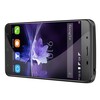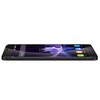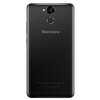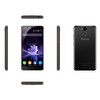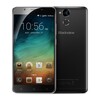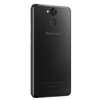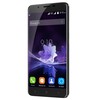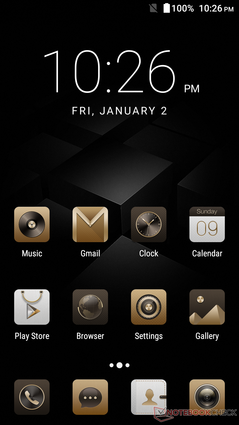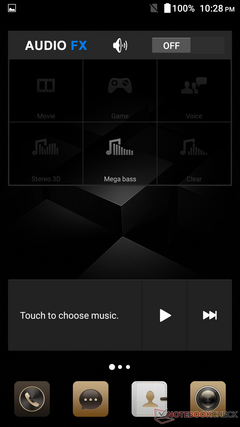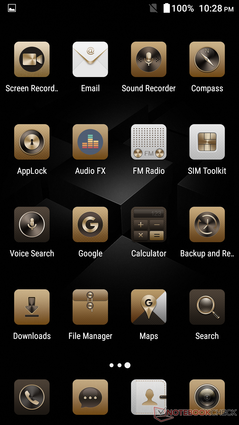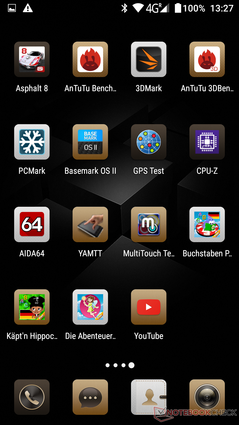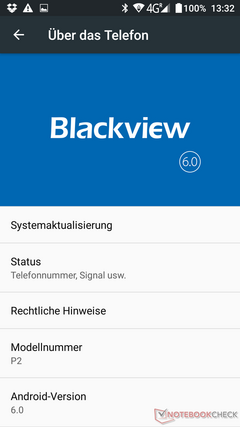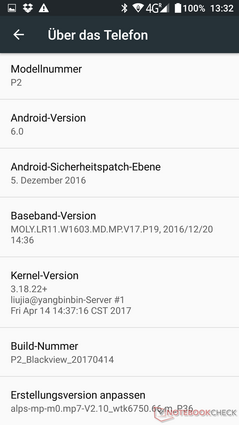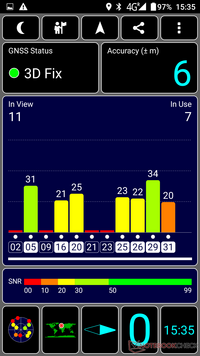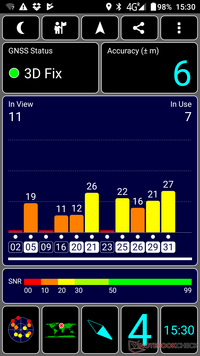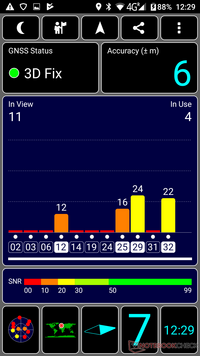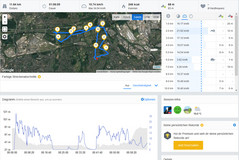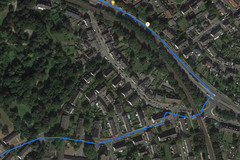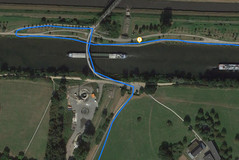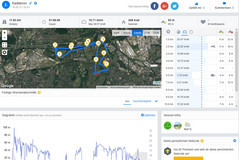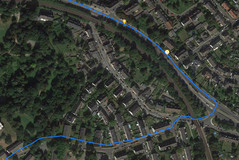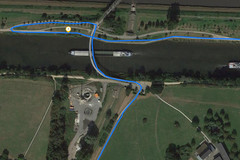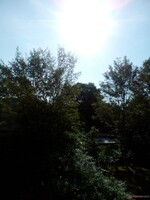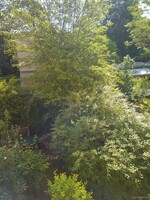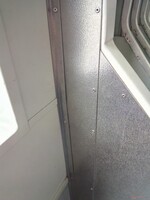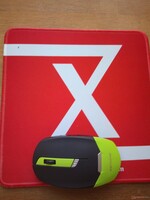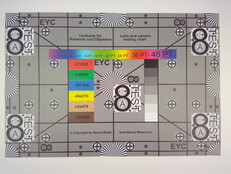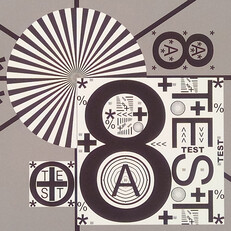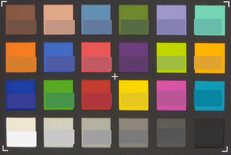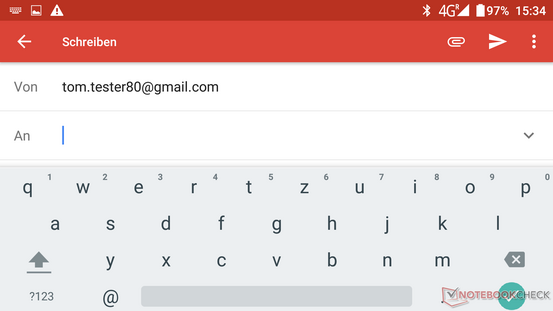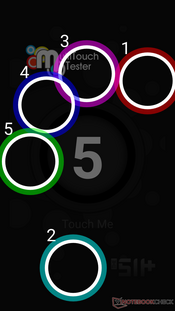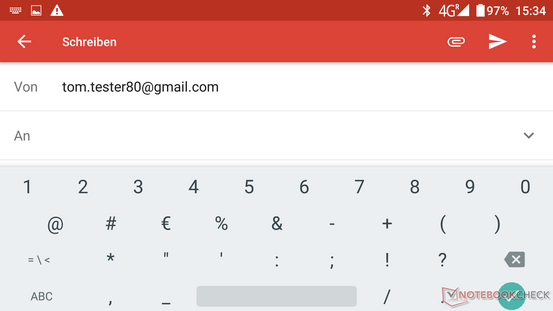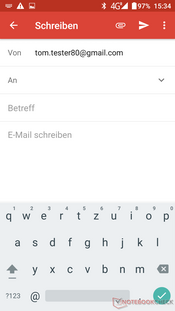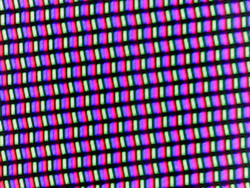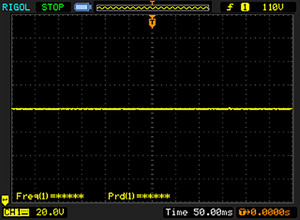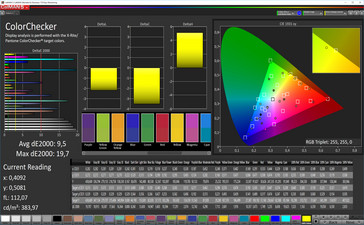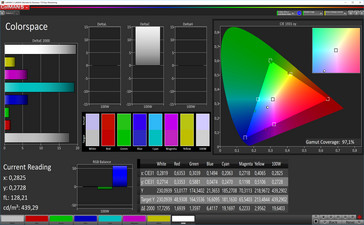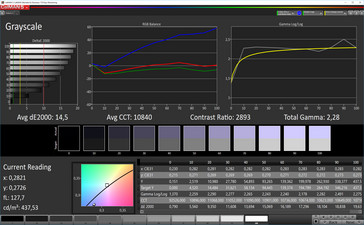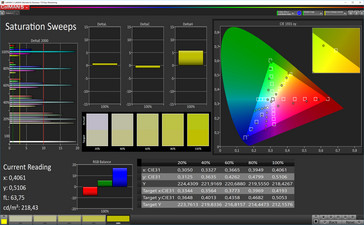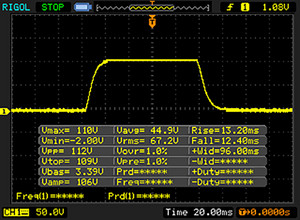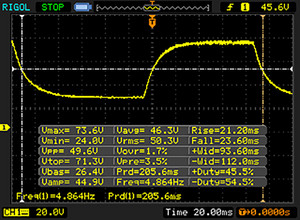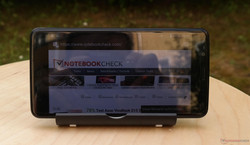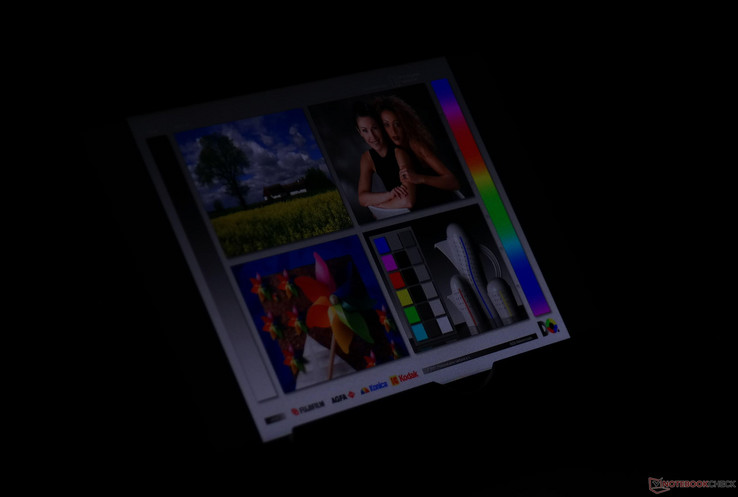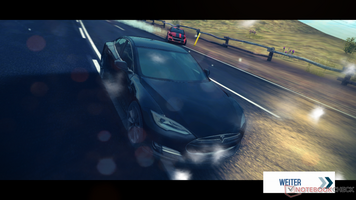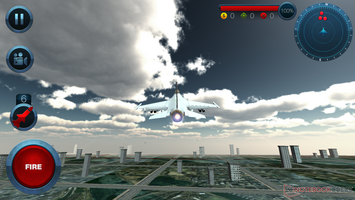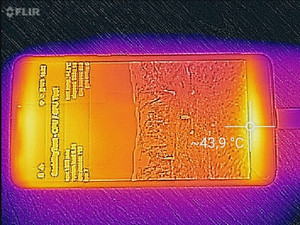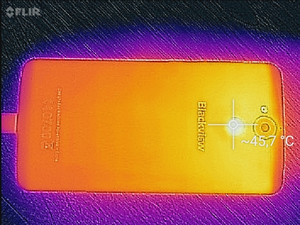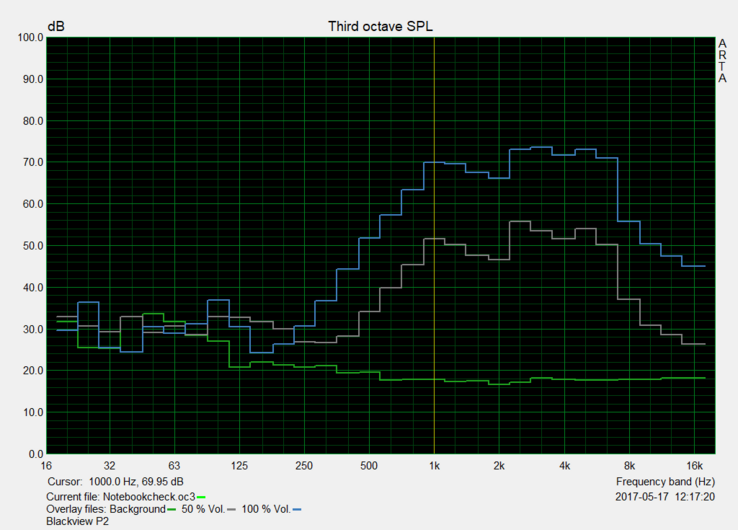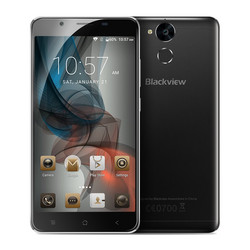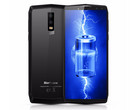Blackview P2 Smartphone Review

For the original German review, click here.
More and more Chinese manufacturers are entering the world market. Not through direct sales in target countries, but rather via numerous Chinese shops that are willing to deliver the devices all over the world if necessary. One of these manufacturers is Blackview - not to be confused with the BlackBerry devices now sold by TLC, which the manufacturer is probably alluding to on purpose. The mobile phones are black with a stylized black background - similar to the BlackBerry operating system. Like BlackBerrys, the phone itself runs on Android. The model in this review, the P2, runs on an Android version that is not quite up to date anymore: version 6.0. The 230 g (~8.11 oz) heavy device has a lot to offer: 4 GB of RAM, a 64 GB eMMC, a Full HD screen, a large 6000-mAh battery and a dual-SIM option. The manufacturer that is usually focused on hardy outdoor phones has not yet presented a lot of devices, so we will compare our test unit with some Far-Eastern colleagues. We have chosen the Oukitel U16 Max with a similarly large battery, the ZTE Blade V8 and our test unit's slim sibling, the Blackview R6.
Case
You notice the 230 grams (~8.11 oz) as soon as you pick up the phone: it is rather heavy. Apart from that the device seems to be well made. The large metal back suits the manufacturer's focus on producing hardy smartphones. The same goes for the large screen, curved at the sides. The black color highlights this impression of indestructibility. Still, the device feels good. It has a 13-megapixel main camera with flash and fingerprint sensor on the back. The entire back cover seems to magnetically attract fingerprints. Blackview has decided to keep the design traditional with some added gimmicks: the power button has a ridged pattern, which makes it easier to differentiate between the power and volume buttons. The battery cannot be changed.
Connectivity
The Blackview P2 is equipped with the MT6750 octa-core processor from MediaTek, which is one of the faster low-budget processors. Apart from some very demanding games, the processor should not give you any difficulties. While the manufacturer saved a little on the processor, it did not save on other specifications: 4 GB of RAM is an exception for this price level; 64 GB eMMC storage, a 13-megapixel main camera, an 8-megapixel front camera and a large battery with 6000 mAh are what we would expect from a device that is available for $160 on Gearbest. The 5.5-inch display has Full HD resolution. The Android version 6.0 is not quite up to date anymore and probably will not receive an update either. The device comes with a power supply, a headset lacking bass and a see-through silicon case.
The ports are positioned as you would expect. There is an extractable slot for SIM and microSD card. You can either insert two nano-SIM cards or one SIM card and one microSD card of up to 128 GB (according to the manufacturer). On the other side you will find the volume rocker and power button. The USB 3.0 Type-C port supports OTG and is positioned at the bottom of the device, between the openings for the speakers. The device comes with a suitable cable. The audio jack is positioned at the top right of the device. There is a fingerprint sensor at the back, just below the main camera, which takes the phone out of standby quickly and reliably.
The Google buttons are capacitive buttons below the screen. They are not illuminated and are light gray, which makes it difficult to see them in darker lighting. Users would need to know where they are to be able to use them properly.
Software
The Blackview P2 runs on Android 6.0 (Marshmallow), which is not quite up to date anymore. It is complemented by a custom interface with a gold logo that gives a noble touch. There is no separate app drawer; instead, all apps are shown on the home screen, similar to the iPhone.
Blackview has already announced an update to Android 7.0.
An important factor when talking about devices from the Far East: The Google Play Store is preinstalled together with some standard Google apps. The phone is not rooted or set to developer mode and comes without advertising apps that cannot be removed. There are some additional apps such as App-Lock and Screenrecorder, but these are not bothersome and fit into the domain of helpful additions. Our routine virus scan found no viruses or malware on the device. Overall, a model example. According to some forums, Blackview offers updates for its devices occasionally, but their installation is not particularly user-friendly.
Communication & GPS
The Blackview P2 is equipped with current radio technology. It has fast Wi-Fi, although the manufacturer has given no detailed information about its specifications, and it has Bluetooth 4.1. It has integrated GPS which transmits on 2G, 3G and 4G frequencies as well as on the 800, 1800 and 2600 MHz radio spectrum. The LTE is supposed to be a cat. 6 standard with a maximum download rate of 300 MBit/s and 50 Mbit/s upload speed.
The Wi-Fi has good transfer rates in comparison to its competitors. Only the Oukitel could beat it. However, the speeds correspond more to the 802.11 n standard; the throughput would have to be a lot higher for ac. We therefore assume that the device is only equipped with an 802.11 n module.
| Networking | |
| iperf3 transmit AX12 | |
| Oukitel U16 Max | |
| Blackview P2 | |
| ZTE Blade V8 | |
| Blackview R6 | |
| iperf3 receive AX12 | |
| Oukitel U16 Max | |
| Blackview P2 | |
| ZTE Blade V8 | |
| Blackview R6 | |
According to the manufacturer, the Blackview only supports GPS reception and is of mediocre quality. The position is updated less often than for the Garmin Edge, which makes the route less exact, but it is still precise enough. Satellite-positioning is accurate within five or six meters. The number of satellites can drop when you are in the car, and the device often has no connection at all indoors.
Telephone & Voice Quality
Blackview uses the standard telephone app from Android and has decorated its symbol with gold details. The basic design is not gold, however, and therefore seems a little out of place. We did a test call and voice quality was good in both directions. We did not notice any noise or other background sounds.
Cameras
The Blackview P2 has an 8 MP front camera and a 13 MP main camera and promisingly high resolution, but the meager image quality tells another story. The images from the selfie camera are too dark, but color reproduction is good. The main camera on the other hand is too light and colors appear washed-out. Color reproduction seems to vary depending on what you point the lens at.
Despite their high resolution the cameras’ pictures are not impressive, although color distortion is not that bad. If you take a closer look at the images, you will see that even pictures taken in full sunlight have noticeable noise and often details are not sharp. But luckily, high resolution saves the day again. The camera clearly has difficulties with grayscales, for example white becomes a light beige. Unfortunately, we cannot say that the cameras are good. But they should suffice for taking snapshots for WhatsApp or private blogs.
The front camera’s color display subjectively gives a better impression, despite the images being too dark. The main camera creates rather pale images. The camera is fine for Skype conversations, but it is not so suitable for printable selfies.
Accessories and Warranty
The P2 comes with a power supply, a USB charging cable, an OTG cable and not particularly nice-sounding headphones. The box also contains a close-fitting transparent silicon case. There is a small booklet that describes the functions of the Blackview P2 in English, Russian and Spanish. The manufacturer offers no further accessories on its website.
We inquired about warranty and Blackview confirmed that they currently do not offer any warranty. Some devices are sold on Amazon, which gives you a little more security. Please see our Guarantees, Return policies and Warranties FAQ for country-specific information.
Input Devices and Handling
The Blackview P2 is equipped with a multi-gesture touchscreen that reacts to inputs quickly and smoothly.
If the user needs to type something, the standard Android keyboard appears. Screen rotation is a little slow. The position sensor has no difficulties in games like Asphalt 8.
Display
The display has IPS technology and can be read from any position. The Full HD resolution is more than enough for a device of this size, so you should not see any individual pixels. Maximum brightness is at 400 cd/m², although the distribution of brightness could be better. Some of the direct competitors such as the Oukitel U16 Max have lower resolutions. But that should only be relevant for pixel fanatics.
| |||||||||||||||||||||||||
Brightness Distribution: 85 %
Center on Battery: 424 cd/m²
Contrast: 2827:1 (Black: 0.15 cd/m²)
ΔE ColorChecker Calman: 9.5 | ∀{0.5-29.43 Ø4.77}
ΔE Greyscale Calman: 14.5 | ∀{0.09-98 Ø5}
Gamma: 2.28
CCT: 10840 K
| Blackview P2 IPS, 1920x1080, 5.5" | ZTE Blade V8 IPS, 1920x1080, 5.2" | Blackview R6 IPS, 1920x1080, 5.5" | Oukitel U16 Max 1280x720, 6" | |
|---|---|---|---|---|
| Screen | -23% | -18% | -12% | |
| Brightness middle (cd/m²) | 424 | 482 14% | 352 -17% | 417 -2% |
| Brightness (cd/m²) | 420 | 448 7% | 320 -24% | 405 -4% |
| Brightness Distribution (%) | 85 | 79 -7% | 81 -5% | 94 11% |
| Black Level * (cd/m²) | 0.15 | 0.64 -327% | 0.3 -100% | 0.21 -40% |
| Contrast (:1) | 2827 | 753 -73% | 1173 -59% | 1986 -30% |
| Colorchecker dE 2000 * | 9.5 | 4 58% | 8.7 8% | 11.9 -25% |
| Colorchecker dE 2000 max. * | 19.7 | 6.5 67% | 15.1 23% | 21.5 -9% |
| Greyscale dE 2000 * | 14.5 | 3.4 77% | 10.5 28% | 14.4 1% |
| Gamma | 2.28 96% | 2.13 103% | 2.04 108% | 2.19 100% |
| CCT | 10840 60% | 6774 96% | 8529 76% | 12820 51% |
* ... smaller is better
Screen Flickering / PWM (Pulse-Width Modulation)
| Screen flickering / PWM not detected | |||
In comparison: 53 % of all tested devices do not use PWM to dim the display. If PWM was detected, an average of 8084 (minimum: 5 - maximum: 343500) Hz was measured. | |||
Compared with the competition, the display does a good job: high contrast, good black levels and high brightness. The DeltaE results sort the wheat from the chaff: the ZTE Blade is the clear winner. Direct imports from China all have difficulties with blue cast which shows clearly in the graphs. Subjectively, there are no big problems.
Display Response Times
| ↔ Response Time Black to White | ||
|---|---|---|
| 25.6 ms ... rise ↗ and fall ↘ combined | ↗ 13.2 ms rise | |
| ↘ 12.4 ms fall | ||
| The screen shows relatively slow response rates in our tests and may be too slow for gamers. In comparison, all tested devices range from 0.1 (minimum) to 240 (maximum) ms. » 60 % of all devices are better. This means that the measured response time is worse than the average of all tested devices (20.2 ms). | ||
| ↔ Response Time 50% Grey to 80% Grey | ||
| 44.8 ms ... rise ↗ and fall ↘ combined | ↗ 21.2 ms rise | |
| ↘ 23.6 ms fall | ||
| The screen shows slow response rates in our tests and will be unsatisfactory for gamers. In comparison, all tested devices range from 0.165 (minimum) to 636 (maximum) ms. » 75 % of all devices are better. This means that the measured response time is worse than the average of all tested devices (31.6 ms). | ||
Performance
The Blackview P2 is equipped with an MT6750 octa-core processor from MediaTek with eight cores that reach a clock rate of up to 1500 MHz, and an ARM Mali-T860 MP2 graphics chip. Neither unit promises any miracles. They are, however, suitable for all Android users that do not wish to regularly download the newest 3D games or wish to use the phone for occasional "serious" tasks. The benchmark results confirm our expectations. The Blackview is on a par with its similarly equipped competitors.
RAM is quite large at 4 GB, but it is rather slow at 800 MBit/s.
The P2 cannot offer a fast card reader and is among the last in our test with the Toshiba Exceria Pro SDXC 64 GB UHS-II reference card. But there is not much difference to the other competitors from the Far East. Only the ZTE Blade goes the extra mile. The speed of the integrated memory brings better results and our Blackview can keep up with the competition, and even overtake some of it.
| AnTuTu v6 - Total Score (sort by value) | |
| Blackview P2 | |
| ZTE Blade V8 | |
| Blackview R6 | |
| Oukitel U16 Max | |
| Geekbench 4.0 | |
| 64 Bit Single-Core Score (sort by value) | |
| ZTE Blade V8 | |
| Blackview R6 | |
| 64 Bit Multi-Core Score (sort by value) | |
| ZTE Blade V8 | |
| Blackview R6 | |
| GFXBench (DX / GLBenchmark) 2.7 | |
| T-Rex Onscreen (sort by value) | |
| Blackview P2 | |
| ZTE Blade V8 | |
| Blackview R6 | |
| Oukitel U16 Max | |
| 1920x1080 T-Rex Offscreen (sort by value) | |
| Blackview P2 | |
| ZTE Blade V8 | |
| Blackview R6 | |
| Oukitel U16 Max | |
| GFXBench 3.0 | |
| on screen Manhattan Onscreen OGL (sort by value) | |
| Blackview P2 | |
| ZTE Blade V8 | |
| Blackview R6 | |
| Oukitel U16 Max | |
| 1920x1080 1080p Manhattan Offscreen (sort by value) | |
| Blackview P2 | |
| ZTE Blade V8 | |
| Blackview R6 | |
| Oukitel U16 Max | |
| GFXBench 3.1 | |
| on screen Manhattan ES 3.1 Onscreen (sort by value) | |
| Blackview P2 | |
| ZTE Blade V8 | |
| Blackview R6 | |
| Oukitel U16 Max | |
| 1920x1080 Manhattan ES 3.1 Offscreen (sort by value) | |
| Blackview P2 | |
| ZTE Blade V8 | |
| Blackview R6 | |
| Oukitel U16 Max | |
| PCMark for Android | |
| Work performance score (sort by value) | |
| Blackview P2 | |
| ZTE Blade V8 | |
| Blackview R6 | |
| Oukitel U16 Max | |
| Computer Vision score (sort by value) | |
| Blackview P2 | |
| Oukitel U16 Max | |
| Storage score (sort by value) | |
| Blackview P2 | |
| Oukitel U16 Max | |
| Work 2.0 performance score (sort by value) | |
| Blackview P2 | |
| ZTE Blade V8 | |
| Oukitel U16 Max | |
| Octane V2 - Total Score (sort by value) | |
| Blackview P2 | |
| ZTE Blade V8 | |
| Blackview R6 | |
| Oukitel U16 Max | |
| Mozilla Kraken 1.1 - Total (sort by value) | |
| Blackview P2 | |
| ZTE Blade V8 | |
| Blackview R6 | |
| Oukitel U16 Max | |
| JetStream 1.1 - Total Score (sort by value) | |
| Blackview P2 | |
| ZTE Blade V8 | |
| Blackview R6 | |
| Oukitel U16 Max | |
| AndroBench 3-5 | |
| Sequential Write 256KB SDCard (sort by value) | |
| Blackview P2 | |
| ZTE Blade V8 | |
| Blackview R6 | |
| Oukitel U16 Max | |
| Sequential Read 256KB SDCard (sort by value) | |
| Blackview P2 | |
| ZTE Blade V8 | |
| Blackview R6 | |
| Oukitel U16 Max | |
| Random Write 4KB (sort by value) | |
| Blackview P2 | |
| ZTE Blade V8 | |
| Blackview R6 | |
| Oukitel U16 Max | |
| Random Read 4KB (sort by value) | |
| Blackview P2 | |
| ZTE Blade V8 | |
| Blackview R6 | |
| Oukitel U16 Max | |
| Sequential Write 256KB (sort by value) | |
| Blackview P2 | |
| ZTE Blade V8 | |
| Blackview R6 | |
| Oukitel U16 Max | |
| Sequential Read 256KB (sort by value) | |
| Blackview P2 | |
| ZTE Blade V8 | |
| Blackview R6 | |
| Oukitel U16 Max | |
* ... smaller is better
Games
The installed graphics solution ARM Mali-T860 MP2 is not the fastest, but it managed to keep up quite well during our tests, for example with Asphalt 8. Older games should be displayed with no problems. The position sensor reacted fast enough while playing. In our test with a piano-playing app the key hits were registered satisfyingly quickly. We only noticed a slight delay when playing very fast.
Emissions
Temperature
(±) The maximum temperature on the upper side is 41.9 °C / 107 F, compared to the average of 35.2 °C / 95 F, ranging from 21.9 to 247 °C for the class Smartphone.
(±) The bottom heats up to a maximum of 40.5 °C / 105 F, compared to the average of 34 °C / 93 F
(±) In idle usage, the average temperature for the upper side is 33.1 °C / 92 F, compared to the device average of 32.9 °C / 91 F.
Speakers
The Blackview has good, mid-range speakers. They are well protected and hidden beneath the aluminum case. The volume is loud enough to fill a small room. But of course, sound quality is rather mediocre. As with all speakers of this size, there is hardly any bass. Sound quality does not really improve when you connect the provided headphones as these also have very little bass. If you put the speakers to your ear, you can hear a slight murmuring.
Blackview P2 audio analysis
(±) | speaker loudness is average but good (80.8 dB)
Bass 100 - 315 Hz
(-) | nearly no bass - on average 24.9% lower than median
(±) | linearity of bass is average (13.6% delta to prev. frequency)
Mids 400 - 2000 Hz
(±) | higher mids - on average 9.3% higher than median
(±) | linearity of mids is average (12.3% delta to prev. frequency)
Highs 2 - 16 kHz
(±) | higher highs - on average 12.6% higher than median
(±) | linearity of highs is average (12.6% delta to prev. frequency)
Overall 100 - 16.000 Hz
(-) | overall sound is not linear (38.7% difference to median)
Compared to same class
» 86% of all tested devices in this class were better, 0% similar, 14% worse
» The best had a delta of 11%, average was 35%, worst was 134%
Compared to all devices tested
» 95% of all tested devices were better, 1% similar, 5% worse
» The best had a delta of 4%, average was 24%, worst was 134%
Oukitel U16 Max audio analysis
(+) | speakers can play relatively loud (82.8 dB)
Bass 100 - 315 Hz
(-) | nearly no bass - on average 29.7% lower than median
(±) | linearity of bass is average (12% delta to prev. frequency)
Mids 400 - 2000 Hz
(±) | higher mids - on average 9.1% higher than median
(±) | linearity of mids is average (9% delta to prev. frequency)
Highs 2 - 16 kHz
(±) | higher highs - on average 9.2% higher than median
(±) | linearity of highs is average (10.2% delta to prev. frequency)
Overall 100 - 16.000 Hz
(-) | overall sound is not linear (38% difference to median)
Compared to same class
» 86% of all tested devices in this class were better, 1% similar, 14% worse
» The best had a delta of 11%, average was 35%, worst was 134%
Compared to all devices tested
» 94% of all tested devices were better, 1% similar, 5% worse
» The best had a delta of 4%, average was 24%, worst was 134%
Frequency diagram in comparison (checkboxes above can be turned on/off)
Battery Runtime
Power Consumption
The device has rather good power consumption rates. Compared to other Chinese devices it manages its power very well. Maximum consumption is below 6 Watt. The Oukitel U16 Max needs another 2 Watt more. Still, consumption could also be lower. The power supply is rather large and supplies 2 Ampere. It recharges the phone quickly.
| Off / Standby | |
| Idle | |
| Load |
|
Key:
min: | |
Battery Runtime
As expected, the P2 did quite well in the battery test. It can manage an entire workday, and more if necessary, under full load. That is not surprising for a 6000-mAh battery. However, there are also devices that can keep going for almost 40 hours in idle, despite having half the battery size - for example the Honor 6X. The high battery power takes its toll on the device’s weight. This is a compromise that you do not have to make with the Honor if you are willing to pay $100 more.
| Blackview P2 6000 mAh | ZTE Blade V8 2730 mAh | Blackview R6 3000 mAh | Oukitel U16 Max 4000 mAh | Honor 6X 3340 mAh | |
|---|---|---|---|---|---|
| Battery runtime | -44% | -54% | -30% | -10% | |
| Reader / Idle (h) | 32.6 | 16.1 -51% | 26.2 -20% | 37.5 15% | |
| WiFi v1.3 (h) | 18.1 | 11.7 -35% | 10.1 -44% | 12.2 -33% | 16 -12% |
| Load (h) | 9.4 | 5 -47% | 3.4 -64% | 5.8 -38% | 6.3 -33% |
| H.264 (h) | 9.1 | 14.8 |
Pros
Cons
Verdict
The Blackview's biggest weakness is quite obvious: It is very heavy. Apart from that, there is not much to complain about. It has a timeless design and is inconspicuous but not boring. The screen is bright, the device is sturdy. You cannot compare the camera with devices that cost five times as much; for this price, the phone has great connectivity: 4 GB of RAM and 64 GB eMMC and processor speeds are good too. If you are looking for a reasonable, sturdy and well-equipped smartphone and are not bothered by its weight, this device might be the right choice.
A paperweight with great connectivity and good price-performance ratio.
It might be worth paying a few dollars more and buying the phone through a local distributor as Blackview does not offer warranty.
Blackview P2
- 06/20/2017 v6 (old)
Florian Schaar





